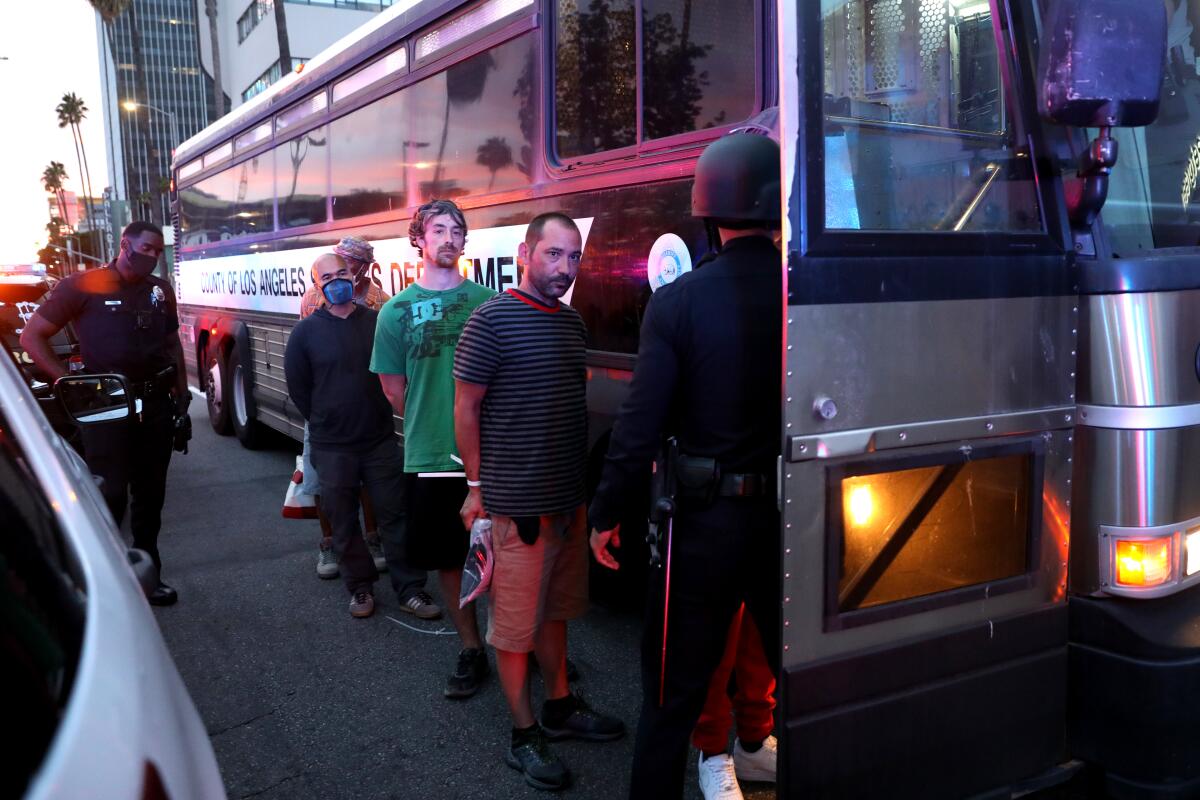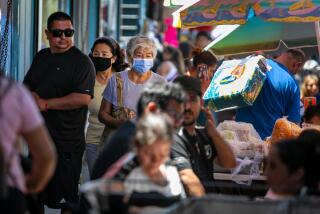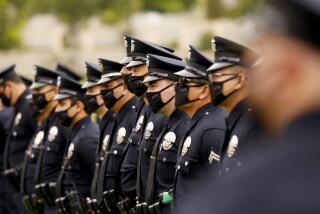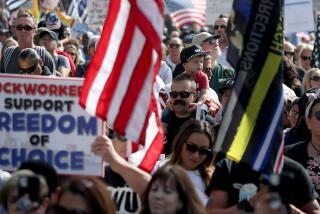LAPD packed arrested protesters in confined space for hours, heightening coronavirus risk

- Share via
After spending months closely observing health officials’ warnings about the dangers of the coronavirus, Stephanie Van Sickel had a decision to make as protesters marched through downtown L.A. late last month.
Van Sickel, 32, lives with a nurse who had been getting tested for the virus at least once a week. She knew that joining the crowds of thousands who had taken to the street to protest the killing of George Floyd and larger issues with police brutality would increase her chances of getting sick, but she also felt compelled to get off the sidelines.
“It was definitely a big decision she and I made going out there,” Van Sickel said. “But we decided there are some things that are more important than your own personal safety.”
Van Sickel said she spent three hours marching throughout downtown L.A., mostly with groups of people who were masked and observing social distancing. But by the end of the night, her hands were zip-tied together as she was crammed onto a bus and put in close contact with other demonstrators. They were all under arrest for violating a dispersal order many of them would later claim they never heard.
Van Sickel said her mask had fallen off. None of the officers she’d interacted with had worn one to begin with.
“At that point, obviously, anxiety is skyrocketing ... but they clearly do not care,” she said of the officers.
In the past few weeks, hundreds of thousands of people have taken part in marches across the country to call for criminal justice reform in the wake of Floyd’s killing, prompting concerns from many that the large crowds could lead to a spike in coronavirus cases. But in Southern California, where thousands of people were arrested for minor violations during the demonstrations, some are now questioning if the police response to the protests might do more to get people sick than the protests themselves.
“Certainly, the big roundups of people that threatened their health were really not supportable. They are not really able to justify them in terms of whatever danger [the protesters] posed,” said L.A. County Supervisor Sheila Kuehl, who introduced a motion this week calling on health officials to provide police with guidelines on how to improve responses to protests during the pandemic. “It was like they freaked out because there were a lot of people there.”
Several epidemiologists told The Times that while protests themselves could spread the virus, the conditions the LAPD and other agencies held people in were even more problematic for those worried about a surge in cases.
“If you are packing people together on buses, particularly if the windows are closed … that will promote COVID-19 transmission if there are infected and susceptible people on those buses,” said Dr. Timothy Brewer, a professor of medicine and epidemiology at UCLA.
While departments have been slow to provide detailed arrest figures, most estimates suggest more than 3,000 people in Southern California were taken into custody during the height of the protests from May 29 to June 2. The LAPD arrested 2,700 people in that time frame, and officials have estimated about 2,500 of those arrests were for violations of emergency curfew orders or dispersal orders. Only a fraction were related to reports of theft and vandalism at businesses downtown, in the Fairfax District and in Van Nuys.
Curfew and dispersal order violations result only in a citation, for which people can be issued a ticket and released immediately, attorneys say. The fact that the LAPD chose to instead put those people on buses or pack them together in groups during a pandemic that spreads rapidly through the air in enclosed spaces showed that police prioritized detaining nonviolent protesters over those people’s health, said civil rights attorney Carol Sobel.
Allegations that booking conditions could have promoted the spread of the coronavirus among protesters could be added to a lawsuit filed against the city over its response to the demonstrations, said Sobel.
LAPD Chief Michel Moore said the department is reviewing the way protesters were detained as part of its larger review of the department’s response. The review “will include understanding what protective measures were attempted in the transportation and processing of arrestees,” Moore said.
Complaints that police officers’ actions put demonstrators at added risk of getting sick extended beyond Los Angeles. In Santa Monica, 22-year-old Steve Doaty said officers took away protesters’ masks when they arrested people for curfew violations on the night of May 31. Doaty said he was one of dozens of people kept in custody for hours and processed at the Santa Monica airport.
“I’m not sure what’s gong on with this. They preached social distancing and stuff like that, but then they took our masks and put us close together?” Doaty asked.
In a statement, Santa Monica officials said they are conducting a full review of what took place during a day of demonstrations that also saw destruction and vandalism at several businesses in the Promenade shopping district.
“We value peaceful protest and are committed to a city in which all residents and visitors feel and are safe,” the statement read.
Late last month, the California Department of Public Health issued guidelines for those looking to protest during the pandemic, warning that “activities like chanting, shouting, singing and group recitation negate the risk-reduction achieved” by social distancing.
Dr. George Rutherford, a professor of epidemiology at the University of California in San Francisco, said the conditions described by people arrested in Southern California seemed inconsistent with public health guidelines aimed at reducing the spread of the illness. While protesting carries its own risks of contracting COVID-19, the large number of officers seen without masks and their decision to hold people in close quarters worsened the situation.
“It’s only a finite amount of time but it is time and it does increase risk,” he said. “The virus has less room to disperse if someone is coughing, or sneezing or just breathing.”
Some said officers’ apparent indifference to wearing masks or holding protesters in cramped spaces during a pandemic pointed to a larger, cultural problem.
“The people that are supposed to be protecting us might be spreading this virus more than anyone,” said Jeremey Penn, a 30-year-old game developer who volunteers with the L.A. chapter of the Democratic Socialists of America. “How are we supposed to protect ourselves if they aren’t?”
Times staff writer Emily Alpert Reyes contributed to this report.
More to Read
Sign up for Essential California
The most important California stories and recommendations in your inbox every morning.
You may occasionally receive promotional content from the Los Angeles Times.











